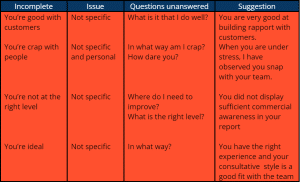In a high-performing environment, everything is measured, and individual performance has a significant impact on team performance output. The ability to get the most out of your team by ensuring that each member contributes fairly is critical to success in performance management.
This module will help you to-
- Set meaningful objectives
- Give effective feedback
- Build successful plans to improve performance
Attitude to Performance
We frequently talk about holding people in high regard. When we coach someone, we do so with the belief that they can improve. If we want to manage performance by implementing a performance improvement plan, we should do so with the expectation that their performance will improve.
Maintaining this attitude will ensure that we take a balanced and fair approach to the plan while still respecting the team member.
The performance cycle
Everything needs a structure and performance management is no exception.
- Stating expectations- All parties need to be clear on what is expected. A S.M.A.R.T goal is the most used format, and clarity on timing is essential. Think carefully about its communication. Is everyone informed who needs to be and has the goal been recorded? Remember SMART stands for: Specific, Measurable, Attainable, Realistic and Time bound.
- Support- For the sake of fairness we need to consider all aspects of support. What does our subject need to be able to achieve the agreed goal? This could be in the form of training, or tolls for the job. It is vital that we are clear on owners and timescales for any agreed support.
- Implementation- The H.A.M model (Hybrid Annuity Model) is really useful in planning the implementation as it can provide clear milestones. It is also useful in breaking big milestones down into more manageable chunks.
- Reviewing performance- The beauty of a well structured performance improvement plan is that we can monitor performance at every stage. This enables us to correct performance early on and gives us the opportunity to get things back on track with reviewed targets and corrective advice. It makes sense to build regular review dates into your plan.
Managing Performance
Managing performance falls into 3 key areas:
1. Giving clear feedback on the performance
2. Setting a clear action plan that includes objectives
3. Reviewing the plan
Giving Feedback
Why do we give feedback? Feedback is given or received to either promote sustained good performance or to enhance performance. It must be focused on the behavior and be both immediate and specific.
Make it smart-
You will notice that the objectives below have a clear and measurable output.
In managing performance objectives we also need completion dates and owners:
Review
Any action plan needs to be reviewed and monitored. These dates should be agreed and recorded. It can also improve commitment if the review document is signed.
Use what you have learned about feedback to give fair and objective feedback.
Key Outcomes:
- Be specific and clear in your feedback.
- Identify the areas for improvement and set clear actions around these.
- Ensure that objectives are concrete and focus on an output that can be measured.
- Set clear dates for review and monitoring.
- Ensure you deliver on any support needs.








